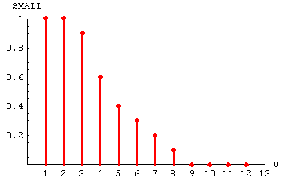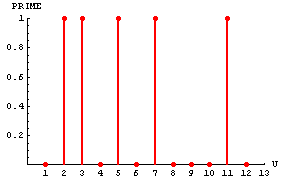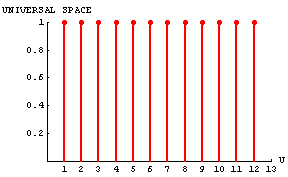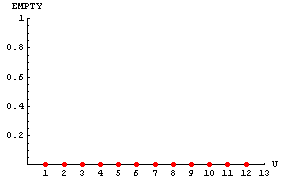|
2.1 Sets Versus Fuzzy Sets
2.1.1 Introduction
This notebook deals with fuzzy sets defined as functions that relate values from the membership function space to the elements from the object space. Based on the structure of the membership function's value, you can define crisp sets and fuzzy sets. An attempt is made to perform a uniform graphical interpretation of the above mentioned types of sets. It is assumed that each of these sets is a finite set. The elements from the objects' space are arranged in sequence. A vertical line is drawn, whose length corresponds to the value of the membership function.
Apart from presentation of crisp sets and fuzzy sets, the basic properties are illustrated by the same graphical method using Fuzzy Logic, along with standard Mathematica functions.
To demonstrate fuzzy set theory, we use many functions from Fuzzy Logic, along with standard Mathematica functions. The Fuzzy Logic package contains numerous functions for working with fuzzy sets and fuzzy logic; this notebook demonstrates only a few of the functions that it contains.
This loads the package.
In[1]:=
2.1.2 Characteristic Function and Membership Function
For a long time humankind has endeavored to understand the laws of the surrounding world and has made continuous attempts to describe the phenomena occurring in the world. Naturally we want to achieve the most adequate descriptions by means of exact and precise terms. Mathematical language should be the best tool to express such descriptions; however, the language of set theory and extensional logic is sometimes insufficient.
Let's recall that in classical set theory, which originated in the work of George Cantor during the years 1871-1883, the notions "element" and "set" and the relation "is an element of" are undefined concepts. Thus, sets are defined by a simple statement describing whether a particular element having a certain property belongs to a particular set. When we consider set X contained in an universal space U, also referred to as the universe of discourse, we can state unequivocally whether each element u of space U is or is not an element of X. Set X is well described by the so-called characteristic function X, introduced by Charles de la Vallee-Poussin [Poussin 1950]. This function, defined on the universal space U, assumes a value of 1 for those elements u that belong to set X, and value of 0 for those elements u that do not belong to set X.
X : U  { 0 , 1 } { 0 , 1 }
X(u) = 1, u is a member of X
X(u) = 0, u is not a member of X
By using mathematical apparatus based on classical set theory, we can describe only "sharp" situations, that is, situations in which there is no doubt as to what is true and what is false, in which there is a sharp boundary between elements having a certain property and other elements of the universal space.
Consider, for example, space U consisting of natural numbers less than or equal to 12.
U = {1, 2, 3, 4, 5, 6, 7, 8, 9, 10, 11, 12}
Then, the set of prime numbers could be described as follows.
PRIME = {u contained in U | u is a prime number}
The elements of set PRIME are defined unequivocally in the following manner.
In[2]:=
Out[2]=
Frequently, we have to deal with "unsharp" phenomena- imprecise situations in which it is difficult to find a boundary between truth and falsehood. Let us consider, for example, the same set of objects U as previously, and within it let us distinguish the set of small numbers SMALL. How can we do it? We can, of course, say that 4 is less than 5, but does that mean that 4 is small and 5 is not? If there are any difficulties with assigning membership in such a simple case, then we can imagine how difficult it is to describe complex systems involving human linguistic descriptions. Aristotelian two-valued logic is ineffective in such cases.
In the 1950s, Kubinski used the notion of a vague term and the notion of an unsharp set [Kubinski 1958, 1960]. This notion was applied to sets in which transition from full membership to non-membership was gradual. Such sets had no sharp boundaries.
In the case of the considered set SMALL, the transition from full membership (e.g., 1 is a member of SMALL) to the lack of membership (e.g., 12 is not a member of SMALL) is smooth. Thus SMALL cannot be described by the characteristic function assuming values in the set {0,1}.
Sets X, like SMALL, which have unsharp boundaries, are well characterized by a function that assigns a real number from the closed interval from 0 to 1 to each element u in the set U.
X : U  [ 0 , 1 ] [ 0 , 1 ]
This function, introduced by Professor Lotfi Zadeh in 1965 and called a membership function [Zadeh 1965], describes to what degree an element u belongs to set X; this is called a fuzzy set. To avoid a complex description like, "a fuzzy set X characterized by the membership function X," J. Goguen [Goguen 1967] proposed to identify a fuzzy set with a function that characterizes it and introduced the following definition:
A fuzzy set X defined in the universal space U is a function defined in U which assumes values in the range [0, 1]. A fuzzy set X will be written as a set of pairs {u, X(u)}:
X = {{u , X(u)}}, u in the set U
where u is an element of the universal space U, and X(u) is the value of the function X for this element. The value X(u) is the grade of membership of the element u in a fuzzy set X.
An empty fuzzy set is a function that for every u in the set U assumes the value of zero. Using the notation just described, we can write this set in the following way.
Empty Set = {{u , 0}}, u in the set U
Space U, treated as a fuzzy set, is a function equal to 1. Presenting set U in the form we just described, we have the following.
U = {{u , 1}}, u in the set U
A classical "sharp" set, A (a subset of U treated as a fuzzy set), is a function assuming the values 0 for u not contained in A and 1 for u contained in A. Set A is thus identified with its characteristic function.
Bearing in mind the concept of a fuzzy set, we shall now resume the presentation of set SMALL of small numbers in set U consisting of natural numbers less than or equal to 12.
Assume:
SMALL(1) = 1 SMALL (2) = 1 SMALL(3) = .9 SMALL(4) = .6
SMALL(5) = .4 SMALL(6) = .3 SMALL(7) = .2 SMALL(8) = .1
SMALL(u) = 0 for u >= 9
According to notion described earlier:
SMALL = {{1, 1}, {2, 1}, {3, .9}, {4, .6}, {5, .4}, {6, .3}, {7, .2}, {8, .1}, {9, 0}, {10, 0}, {11, 0}, {12, 0}}
The important point to note is that such a fuzzy set can be defined precisely by associating with each u its grade of membership in SMALL. Note also that the above assignment defining set SMALL is wholly subjective. This subjectivity in the evaluation of the grade of membership of particular elements in the set is characteristic of fuzzy sets.
In spite of allegations that such descriptions are subjective, it has an important advantage. It enables you to take into account the human experience and intelligence by translating imprecise natural language and human reasoning into a mathematical model for a system.
Subjectivity is also a feature distinguishing otherwise similar probability from membership functions. Lack of precision in determining data is sometimes caused by a lack of clearly defined criteria for classifying variables or parameters. This is a starting point for developing a method for solving such problems. Thus, we can repeat what Kwakernaak [Kwakernaak 1978] said: "with indeterminacy of a fuzzy type, we are dealing with a situation in which we admit the possibility that element u from space U fulfills the condition imposed only to a certain degree. The second type of indeterminacy, randomness, occurs when a given element u in the set U either fully fulfills the condition or does not fulfill it at all, but it is not possibly to determine which of these situations applies. Randomness is thus a result of cognitive indetermination.
It is important to note that in the case of a fuzzy set, it is not meaningful to speak of an object as belonging to or not belonging to that set, except for elements whose grades of membership in the set are unity or zero. A membership function describes to what degree element u belongs to set X, so we may say that everything is a matter of degree.
2.1.3 Graphic Interpretation of Sets
Let's restrict our consideration to a case when the universal space U is at the very most a countable set.
U = {  }, i = 1, 2, ... }, i = 1, 2, ...
From the standpoint of practical applications, this restriction will not be troublesome. In most applications, especially when using computational techniques, a finite number of the elements of set U is taken into consideration.
An assumption of denumerability of the universal space permits a very simple graphic interpretation of the fuzzy sets defined in U. The elements of the collection of objects of space U, due to its denumerability, can be arranged in a sequence. You can plot for each element a segment of height corresponding to the value of the membership function of the given element in the fuzzy set under consideration.
Universal spaces for fuzzy sets and fuzzy relations are defined with three numbers in this package. The first two numbers specify the start and end of the universal space, and the third argument specifies the increment between discrete elements .
For example, the set considered earlier, fuzzy set SMALL of small numbers, defined in the space
U = {  } = {1, 2, 3, 4, 5, 6, 7, 8, 9, 10, 11, 12} } = {1, 2, 3, 4, 5, 6, 7, 8, 9, 10, 11, 12}
may be presented in the following way.
In[3]:=
Out[3]=
In[4]:=
Out[4]=
In[5]:=
In[6]:=

Set PRIME, the prime numbers, which is a classical subset of U, may be presented in the following way.
In[7]:=
In[8]:=

Universal Set
In any application of the theory of sets or fuzzy sets, all sets under investigation will likely be subsets of a fixed set. We call this set the universal space or universe of discourse. We denote this set by U. Universal space U, treated as a fuzzy set, is a function equal to 1 for all elements.
In[9]:=
In[10]:=

Finite and Infinite Universal Space
Universal sets can be finite or infinite. Any universal set is finite if it consists of a specific number of different elements, that is, if in counting the different elements of the set, the counting can come to an end, otherwise a set is infinite.
Examples:
1. Let N be the universal space of the days of the week. N = {Mo, Tu, We, Th, Fr, Sa, Su}. N is finite.
2. Let M = {1, 3, 5, 7, 9, ...}. M is infinite.
3. Let L = {u | u is a lake in Minnesota}. Although it may be difficult to count the number of lakes in Minnesota, L is still a finite universal set.
Empty Set
It is convenient to introduce the concept of the empty set, that is, a set that contains only elements with a grade of membership equal to 0. For example, let EMPTY be a set of people in Minnesota who are older than 120. According to known statistics, EMPTY is an empty set. This set is sometimes called the null set.
In[11]:=
In[12]:=

You can restore the default settings of Fuzzy Logic for FuzzySet and FuzzyPlot.
In[13]:=
In[14]:=
References
J. A. Goguen, L-fuzzy sets, J. Math. Anal. Appl., vol. 18, pp. 145-174, 1967.
G. J. Klir and T. A. Folger, Fuzzy Sets, Uncertainty, and Information, Prentice Hall, Englewood Cliffs, NJ, 1988.
T. Kubinski, Nazwy nieostre, Studia Logica, vol. 7, pp. 115-179, 1958.
T. Kubinski, An attempt to bring logic near to colloquial language, Studia Logica, vol. 10, pp. 61-75, 1960.
H. Kwakernaak, Fuzzy random variables, Part I: Definitions and Theorems, Information Science, vol. 15, pp. 1-15, 1978.
M. S. Stachowicz and M. E. Kochanska, Graphic interpretation of fuzzy sets and fuzzy relations, Mathematics at the Service of Man. Edited by A. Ballester, D. Cardus, and E. Trillas, based on materials of Second World Conf., Universidad Politecnica Las Palmas, Spain, 1982.
Ch. de la Valle Poussin, Integrales de Lebesque, fonction d'ensemble, classes de Baire, 2-e ed., Paris, Gauthier-Villars, 1950.
L. A. Zadeh, Fuzzy sets, Information and Control, vol. 8, pp. 338-353, 1965.
L. A. Zadeh, Probability measure of fuzzy events, J. Math. Anal. Appl., vol. 12, pp. 421-427, 1968.
L. A. Zadeh, Outline of a new approach to the analysis of complex systems and decision processes, IEEE Transactions on Systems, Man , Cybernetics, vol. 3, pp. 22-44, 1973.
L. A. Zadeh, The concept of a linguistic variable and its applications to approximate reasoning - I, Information Sciences, vol. 8, pp. 199-249, 1975.
L. A. Zadeh, The concept of a linguistic variable and its applications to approximate reasoning - II, Information Sciences, vol. 8, pp. 301-357, 1975.
L. A. Zadeh, The concept of a linguistic variable and its applications to approximate reasoning - III, Information Sciences, vol. 9, pp. 43-80, 1975.
H. J. Zimmermann, Fuzzy Set Theory and Its Applications, 2nd ed., Kluwer Academic Publishers, Boston, MA, 1991.
|